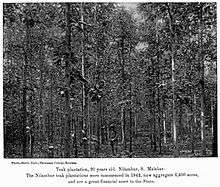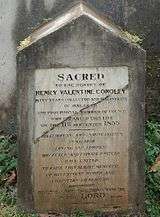Henry Valentine Conolly
Henry Valentine Conolly (5 December 1806 - 11 September 1855) was an East India Company official in the Madras Presidency who served as a magistrate and collector of Malabar. He took an active role in the establishment of teak plantations to meet the demands for teak in ship-building. He was murdered in Calicut by Mappila - Muslim for the actions he sought to take on their leader Sayid Fasal Pukkoya Tangal of Mambrum.

Early life
Henry Conolly was born on 5 December 1806 to Valentine Conolly of 37 Portland Place, London. He was the elder brother of Arthur Conolly and like him was educated at Rugby School, Warwickshire then moved to Madras, India and became a writer in the Madras Civil Service from 19 May 1824. He later served in Bellary as principal collector. He served as a translator of Kannada, a cashier and as commissioner for settlement of claims in the Carnatic.[1][2][3]
Initiatives in India

While District Collector and Magistrate of Malabar Conolly helped develop waterways including a canal now known as the Conolly Canal, initiated 1848, and teak plantations. The teak plantation was a pioneering example of systematic forest management. It contained some of the finest pieces of the tropical hardwood teak. The plantations were constructed by the Madras Government for the supply of teak timber to the port of Bombay.[4][5][6][7] He is also remembered for his planning a coastal waterway in Malabar — what is known today as the Conolly Canal (although the introduction of railways around the time the canal was being completed had eclipsed its importance).[8]
Death

On the evening of 11 September 1855, at around nine o'clock Conolly was attacked at the Collector's Residence at West Hill Bungalow, Calicut by a small group of Mappilas. Conolly was buried in Conolly Park near South Beach Road on 11 September 1855 and the headstone of his tomb was shifted to the premises of the C.S.I. St. Mary's English Church, Calicut in 1997.[9] The murderers, Valassery Emalu, Puliyankunnath Thenu (who had escaped from prison at Calicut a month before) and Haiderman, a hairdresser, were eventually tracked and shot dead by the government forces led by Major Haly and Captain Davis (in an encounter after 6 days at large at Edavannappara in Thiruvambadi). The Mappila rebels were using these escaped prisoners to murder Henry Conolly who suggested the idea of exile of religious leader Sayid Fasal Pukkoya Tangal of Mambrum.[10]
References
| Wikimedia Commons has media related to Henry Valentine Conolly. |
- ↑ H. M. Chichester (rev. James Lunt) (2004). "Conolly, Arthur (1806-1855)". Oxford Dictionary of National Biography. Oxford University Press. doi:10.1093/ref:odnb/6093.
- ↑ Dictionary of Indian Biography - Page 92 CONOLLY, HENRY VALENTINE (1806-1855)
- ↑ Modern English Biography: A-H - Frederic Boase - 1892 Page 1693 "CONOLLY, Henry Valentine"
- ↑ Outlook Traveller May 2008 Vol. 8, n° 5 - Magazine "HV Conolly"
- ↑ The Indian Forester - Volume 27 1901- Page 622
- ↑ Dady Rustomji Banaji Slavery in British India 1933 - Page 125
- ↑ Kamakshi P. Murti India: The Seductive and Seduced "Other" of German Orientalism 2001 Page 105
- ↑ Ramachadran, CK Benign faces of the Raj — the Malabar experience The Hindu January 30, 2012
- ↑ Mohan, R. S. L. (1997). A Brief History of St. Mary's (English) Church, Kozhikode (Calicut), 5 pages.
- ↑ William Logan Malabar Manual - Volume 1 1887 - Page 576